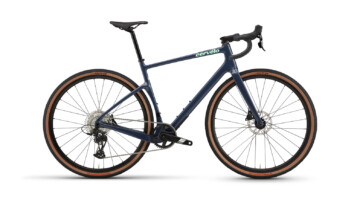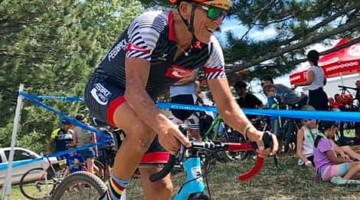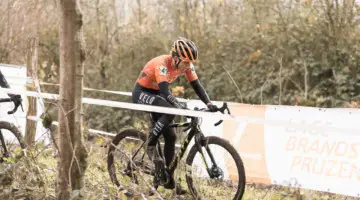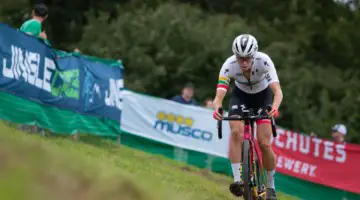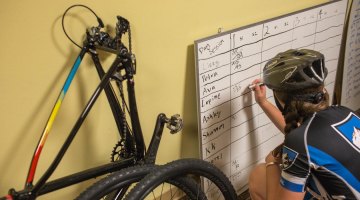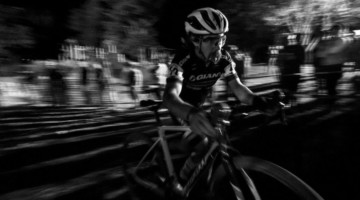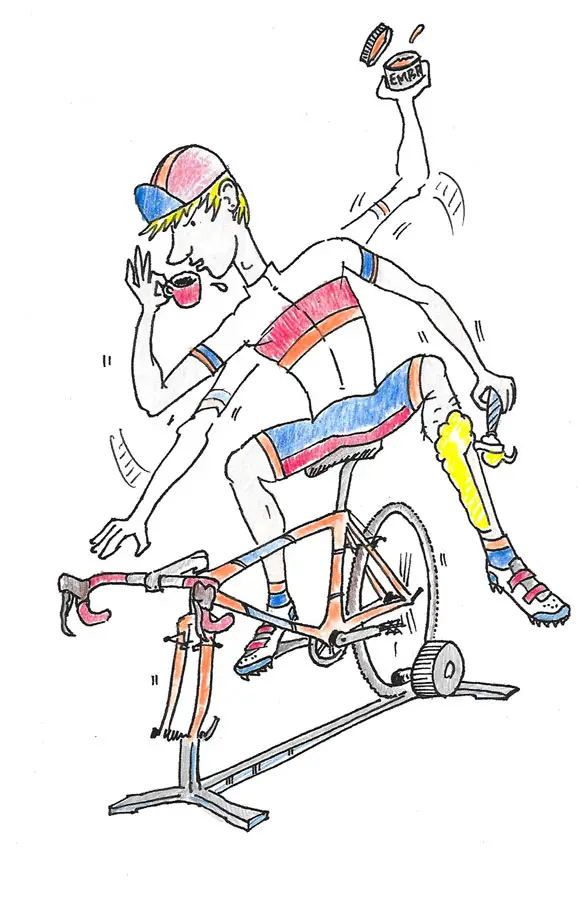 In part three of a four-part series (read part one on leg shaving and embrocation here or part two about caffeine and massage here), which originally appeared in Cyclocross Magazine Issue 29, we take a look at two cyclocross traditions that can strongly affect both your performance and recovery—warming up before a race on the trainer, and post-race cooling down.
In part three of a four-part series (read part one on leg shaving and embrocation here or part two about caffeine and massage here), which originally appeared in Cyclocross Magazine Issue 29, we take a look at two cyclocross traditions that can strongly affect both your performance and recovery—warming up before a race on the trainer, and post-race cooling down.
Read on to see what top pros have to say, and maybe you’ll reevaluate your race day prep. (Illustration by Jeff Rosenhall)
Pre-Race Warm-Ups on the Trainer
That warm and toasty car or nearby lodge looks pretty tempting before a race, but you’re stuck on the outdoor hamster wheel because you’ve been told that warming up before a high-intensity race is critical. You choose between dragging along a road wheel, or risk wearing out your cyclocross treads on rollers, and wonder if your time is better spent sitting closer to the starting line with a nice cup of cocoa. Here’s what the Elites say:
Helen Wyman: I have a sports scientist who I utilize for training and coaching advice. He has given me a significant amount of research on warm-ups when I really wanted to make sure what I was doing was right. I believe they are very useful, but if you are doing it for fun and don’t have time—well, I wouldn’t worry. Just ride the course.
Tim Johnson: In moderation. I see far too many people eschewing course pre-ride time in favor of hours of noodling on a trainer course-side, especially in tough weather conditions—when you need the practice the most!
A short, intense race like cyclocross is helped by being warmed up, but be reasonable—and not every single race has to be treated like the World Championships. Grab a friend, teammate or enemy and go ride around instead—or ride to that one sketchy corner/descent and cheer on your fellow racers.
Jeremy Powers: Warm-ups are extremely important to me—I cannot jump straight into a race without riding at least obviously having a trainer makes that way nicer of an experience.
Cyclocross tends to have weather after October, so it’s good practice. I prefer warming up on the road, but at bigger events with a lot of fans, it’s easier with the trainer. And in bad weather to stay warm and out of the elements, it’s perfect.
Mo Bruno Roy: Warm-ups on the trainer are less important than getting loose out on the course. It can make you feel more relaxed to be settled near your car, gear or team, so it’s worthwhile, but the number-one objective is getting out on the course two times, minimum.
Meredith Miller: I think trainers are valuable. Unless you have a wide-open, traffic-free area to warm up, a trainer is the best way to get a focused and dialed warm-up. Fast starts are important in cyclocross, so you need to be ready from the gun. Also, a trainer allows you to warm up under cover in wet, cold conditions.
Cassie Maximenko: Personally I like warming up on the trainer. It’s not just time to warm up my legs but also my mind. It allows me to set my focus and get pumped before the race.
Josh Johnson: Warming up on a trainer is definitely an important aspect of preparing for a ’cross race. However, in the earlier season races with more favorable weather, I would prefer riding on local roads or bike paths to warm the legs up, and then preview the course. Later in the year when the weather is poor, I’ll hop on the trainer for a bit to warm the legs up before a course preview to inspect the lines and adjust tire pressure. I’ll usually return to the trainer after previewing the course for some more efforts and to stay warm before the race time.
Interested in putting more thought into your pre-race warm up? Be sure to check out our Training Tuesday series, including Adam Myserson’s guide to pre-cyclocross race warm-ups.
Post-Race Cool Downs
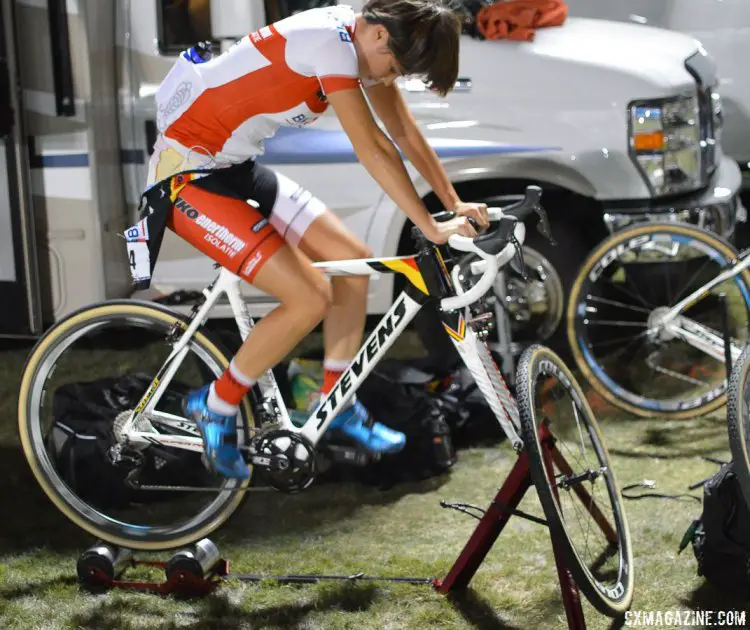
A trainer is nice for a pre-race warm up, or post-race cool down, but you can easily do both on the road. © Clifford Lee / Cyclocross Magazine
You’re coughing up three years’ worth of the car exhaust from your commute. A minute after crossing the finish, you were elated, but that faded a while ago. The backseat is calling your name, and if you could scrunch up your cycling jacket like a pillow, the next hour could mean hibernation mode. As you reach for the nearest beverage of choice, you remember seeing the big names at a recent race actually getting on a trainer after their race was over. The hell with that! Or is that post-race cool-down actually worth the motivational sacrifice? Here’s what the Elites say:
Don Myrah: Cool-downs on a trainer are really something I should have done and didn’t. These days, you see guys on the trainer for 15, even 30 minutes. I think that riders will see far more benefits with cool-downs than getting a massage.
Jeremy Powers: I really like to get at least 10 minutes spin in, but a lot of the time at the races, it doesn’t happen because of podium—if I make the podium on a good day. After that I’ll go directly for a cool-down spin.
Helen Wyman: Isn’t that post-race time for beer drinking and mocking your friends? That’s what I would do if it was acceptable as a pro, and if I liked beer.
Cassie Maximenko: Cool-downs are a must if you plan to race well on day two. It’s also a good time to mentally review the good and bad of the race.
Tim Johnson: Especially on a Saturday afternoon with a Sunday race looming. Grab a jacket and a buddy and roll around chatting about what just went down.
Be sure to plan for your wet and muddy gear and its return from the pits or placement into the car. A clean bike is a happy bike and I’d rather have a clean bike for Sunday instead of “cooled-down” legs.
Josh Johnson: In theory I always plan on cooling down, but in actuality, it’s usually getting dark, I’m hungry and I need to get ready for the next day or head home from the race. However, I do think a cool- down is important, even if it’s short.
The primary thing to remember is be realistic, and get 10 or 15 minutes in rather than trying to get 20 or 30 and decide you don’t have that kind of time and do none. You’ll notice the benefits of a cool-down when doing multiple days of racing back-to-back.

